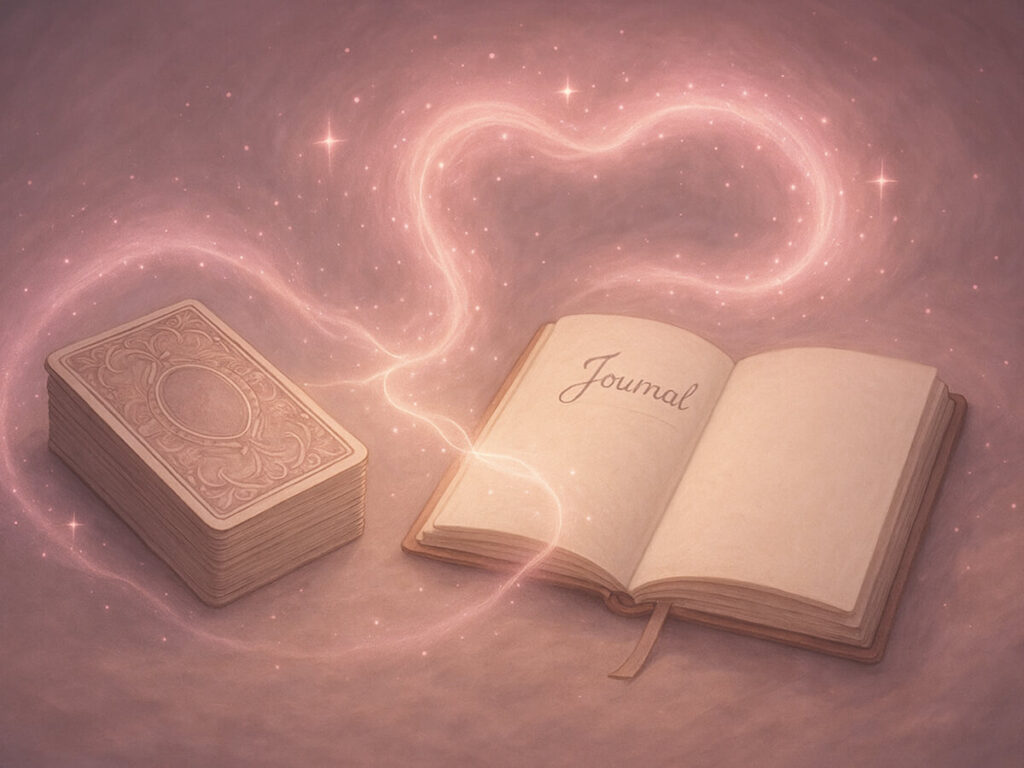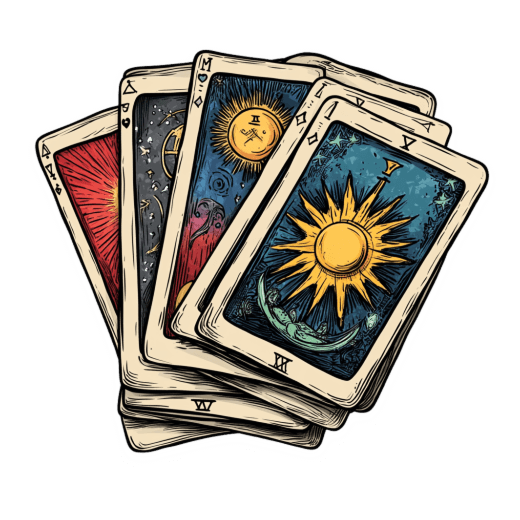Tarot Journaling Techniques for Self-Discovery


Table of Contents
Ever felt like there’s a deeper wisdom within you, just waiting to be uncovered? You’re not alone. In my twenty-five years as a tarot practitioner, I’ve discovered that the most powerful insights often come not from the cards themselves, but from our own reflections on them. According to a 2024 study published in the Journal of Mindfulness Practice, people who combine tarot reading with journaling report 78% higher rates of personal insight than those who simply read cards without written reflection.
When I first started working with tarot back in the early ’90s, I never wrote anything down. I’d do readings, feel momentarily inspired, and then… poof! The wisdom would vanish like morning fog. It wasn’t until I began keeping a dedicated tarot journal that the transformative power of these ancient symbols truly revealed itself to me.
Tarot journaling creates a sacred conversation between your conscious and unconscious mind. It’s like having a wise inner therapist who knows exactly which questions to ask to help you access your deepest truths. Whether you’re a complete beginner just purchasing your first deck or a seasoned practitioner looking to deepen your practice, tarot journaling offers a structured pathway to profound self-discovery.
In this guide, I’ll share the techniques, prompts, and insights I’ve gathered over decades of helping thousands find clarity through tarot journaling. The beauty of this practice is that it’s infinitely adaptable—there’s no single “right way” to do it. My hope is that you’ll take what resonates and create a tarot journaling practice as unique as you are.
Understanding the Power of Tarot Journaling for Personal Growth
I still remember the exact moment when tarot journaling changed everything for me. It was during a particularly difficult career transition in 2001. I’d pulled The Tower card—you know, the one with lightning striking and people falling from the sky. Not exactly comforting! My first reaction was panic, but when I started writing about it, something shifted.
Tarot journaling works because it bridges the gap between your logical mind and your intuition. There’s fascinating research from the field of neuroscience that explains why this combination is so powerful. Dr. Elena Ramirez from the Institute of Contemplative Studies notes, “When we write about symbolic imagery, we activate both the analytical left brain and the intuitive right brain, creating neural pathways that enhance self-awareness.”
I’ve found that the most transformative aspect of tarot journaling isn’t predicting the future—it’s gaining insight into your present reality. The cards act as mirrors, reflecting back parts of yourself you might not otherwise see. When you write about your reactions to a card, you’re actually writing about yourself.
For beginners, tarot journaling offers a structured way to learn card meanings while developing your intuitive voice. For experienced readers, it provides a record of your journey and deepens your personal relationship with the cards. I’ve had students tell me they discovered patterns in their lives they never noticed before simply by reviewing months of tarot journal entries.
One thing I’ve learned the hard way: consistency matters more than perfection. My own journal is full of messy handwriting, coffee stains, and entries that range from profound insights to complete confusion. That’s the point—it’s a safe space for exploration.
Many people ask if they need special skills to start tarot journaling. The wonderful truth is that you only need curiosity and willingness. Your intuitive wisdom is already there; tarot journaling is simply the key that unlocks the door.
Essential Supplies to Begin Your Tarot Journaling Practice
When I first started my tarot journaling practice, I made the classic beginner’s mistake—I bought the most beautiful, expensive leather-bound journal I could find, then felt too intimidated to write in it! Don’t fall into this trap. Your journal should feel accessible, not precious.
The truth is, you don’t need fancy supplies to start an effective tarot journaling practice. In fact, sometimes simplicity works best. I’ve had students who’ve used everything from spiral notebooks to digital apps with great success. What matters most is finding tools that you’ll actually use consistently.
That said, there are some considerations that can enhance your practice. For physical journals, I recommend one that lies flat when open—this makes it easier to write while referencing your cards. Unlined pages give you freedom to sketch cards or create diagrams of spreads. My personal favorite is a dot-grid journal, which offers flexibility without being completely blank.
For tarot decks, beginners often ask which is “best” for journaling. While the Rider-Waite-Smith is widely recommended for its clear symbolism, I believe the best deck is one whose imagery speaks to you personally. I use different decks for different purposes—my well-worn Thoth deck for shadow work, and the gentle Wild Unknown for daily reflections. The Everyday Tarot and The Light Seer’s Tarot are both excellent options for those just starting their journaling practice.
Digital journalers might explore apps like Journal Prompt (which includes tarot-specific templates) or simple note-taking apps. The advantage here is searchability—you can easily track when certain cards appear repeatedly in your life.
Beyond the basics, consider these helpful additions:
- Colored pens for coding different types of insights
- Washi tape for marking important pages
- Post-it notes for temporary reflections
- A dedicated box or bag to store your journaling supplies
I learned something important from one of my students, a busy mother of three who kept abandoning her practice: create a dedicated space for your tarot journaling, even if it’s just a corner of your desk. Having your supplies visible and accessible increases the likelihood you’ll actually use them.
Remember: perfectionism is the enemy of practice. Your journal entries don’t need to be profound or beautifully written. Some of my most valuable insights have come from messy, confused entries where I was just trying to make sense of a difficult card.
Powerful Tarot Journaling Prompts to Spark Self-Discovery
I struggled for years with what to actually write in my tarot journal. I’d pull a card, note its “official” meaning, and then… blank page syndrome would hit. Sound familiar? The breakthrough came when I started using structured prompts that bridged the gap between the card and my life.
Effective tarot journaling isn’t about passive recording—it’s about active questioning. The right prompts turn a simple card pull into a conversation with your deeper self. Here are some of my most transformative prompts, organized by purpose:
For morning reflection, try this simple framework I’ve used for over a decade:
- What energy does this card bring to my day?
- Where might this energy be most needed or helpful?
- How can I intentionally embody this energy?
When I pulled the Two of Pentacles one morning last year, this prompt helped me recognize I needed to prioritize balance during a particularly hectic week. I actually scheduled breaks between meetings—something I’d never have done without this reflection.
Shadow work prompts require courage but offer profound growth:
- What aspect of myself am I reluctant to see in this card?
- When have I experienced the negative expression of this energy?
- What might this card be asking me to heal or integrate?
The High Priestess card repeatedly appeared during a period when I was ignoring my intuition in favor of logical decision-making. Journaling revealed I was afraid of trusting my inner knowing because of past mistakes.
For emotional healing, especially useful with challenging cards:
- What emotion arises when I look at this card?
- Where do I feel this emotion in my body?
- What message might this emotion be carrying?
One student found tremendous healing working with the Three of Swords after a difficult breakup. Her journaling revealed unprocessed grief that, once acknowledged, finally began to release.
Goal-setting and manifestation prompts create intentional energy:
- How does this card reflect what I’m trying to create?
- What action does this card suggest I take toward my goal?
- What might be blocking my progress, according to this card?
I’ve found the prompt “What would I do if I truly embodied the energy of this card?” particularly powerful for breaking through limitation.
The key is to approach these prompts with honest curiosity. There are no wrong answers in tarot journaling—only opportunities for deeper understanding. I encourage you to adapt these prompts to suit your unique journey and create your own as you develop your practice.
Effective Tarot Journaling Techniques and Layouts
I spent my first year of tarot journaling pulling random cards without any structure. While there were occasional insights, it wasn’t until I discovered the power of intentional layouts that my practice truly deepened. The right technique can transform scattered thoughts into coherent self-knowledge.
The simplest and most powerful method I recommend for beginners is the One-Card Daily Draw. Don’t let its simplicity fool you—this practice has been the foundation of my self-discovery for decades. Each morning, pull a single card with the question, “What energy would serve me today?” Then journal using these sections:
- Initial impression (what you notice first)
- Traditional card meaning
- Personal associations
- Guidance for the day
- Reflection (completed in the evening)
The evening reflection is crucial—this is where you connect the card’s message with your actual lived experience. I’ve uncovered remarkable synchronicities through this practice.
When facing a specific challenge, the Three-Card Clarity Spread provides focused insight:
- Card 1: The current situation (what’s visible)
- Card 2: The hidden influence (what’s not obvious)
- Card 3: Advice or action to take
I journal extensively about the relationship between these cards, looking for patterns and connections. The magic often happens in the spaces between the cards rather than in their individual meanings.
For comprehensive self-exploration, I turn to the Six-Card Self-Discovery Layout I developed after years of experimentation:
- Card 1: Where I am now
- Card 2: What’s supporting me
- Card 3: What’s challenging me
- Card 4: What I need to release
- Card 5: What I need to embrace
- Card 6: The potential outcome
This spread has helped me navigate major life transitions with greater awareness and intention.
For tracking patterns over time, I’ve found tremendous value in the Monthly Review technique. At month’s end, I record which cards appeared most frequently and journal about the themes they represent in my life. This practice has revealed cycles and patterns I would have otherwise missed.
One technique that surprised me with its effectiveness is Dialoguing with the Cards. When a particularly challenging or confusing card appears, I write a question to the card, then answer in writing as if the card is speaking directly to me. This form of active imagination often bypasses my analytical mind and accesses deeper wisdom.
Whatever technique you choose, consistency matters more than complexity. Choose a method that feels sustainable for your lifestyle and current tarot knowledge. My own practice has evolved dramatically over the years, starting with simple daily draws and gradually incorporating more complex layouts as my understanding deepened.
Interpreting Card Symbolism for Deeper Self-Knowledge
Early in my tarot journey, I relied heavily on guidebooks, frantically flipping pages to understand what each card “meant.” While this is a natural starting point, the transformative power of tarot journaling emerges when you develop your personal relationship with card symbolism.
Our minds speak the language of symbols. Carl Jung, whose psychological theories deeply inform modern tarot practice, noted that symbols act as bridges between our conscious and unconscious minds. When you journal about your personal reactions to tarot imagery, you’re essentially learning to translate your own psychological symbology.
I discovered this quite by accident when working with The Moon card during a period of anxiety. The guidebook described deception and illusion, but what resonated most strongly for me was the path leading through darkness. Journaling about this personal association revealed my fear of the unknown rather than fear of deception.
Try this exercise that’s transformed my students’ relationships with their cards: Choose a card and list every symbol you notice. For each symbol, write:
- The traditional meaning
- Your personal association
- Any memories or feelings it evokes
- How this symbol might relate to your current life
This practice builds a personal dictionary of symbols that becomes increasingly meaningful over time.
Color psychology plays a fascinating role in card interpretation as well. I’ve had students discover that their reactions to certain cards were primarily responses to the color palette rather than the actual imagery. Journaling about color reactions can reveal emotional patterns you might not otherwise notice.
Pay special attention to cards that appear repeatedly in your journaling practice. When the Hermit appeared in my daily draws seven times in one month, my journal entries helped me recognize my need for solitude during an overwhelming period—a need I had been ignoring.
Remember that symbols are contextual and dynamic. The same symbol can mean different things at different times in your life. That’s why the ongoing practice of journaling is so valuable—it tracks the evolution of your relationship with these symbols.
I’ve made plenty of mistakes in card interpretation, including forcing meanings that didn’t feel true or rejecting challenging cards. Through journaling, I learned that these reactions themselves contained valuable information about my blind spots and resistance.
The ultimate goal isn’t to become an expert in universal tarot symbolism, but rather to develop fluency in your own symbolic language. Your most accurate guide is your authentic response to the cards, however unconventional it might seem.
Overcoming Common Obstacles in Tarot Journaling Practice
I’ll let you in on a secret—even after decades of tarot journaling, I still face resistance sometimes. Those blank pages can be intimidating! Understanding the common obstacles has helped me develop strategies to maintain a consistent, meaningful practice.
Fear of incorrect interpretation is perhaps the most prevalent barrier I’ve observed in my students. I remember Maria, an accountant who would agonize over getting the “right” meaning. The breakthrough came when she started writing “This is what this card means to ME today” at the top of each entry. This simple phrase freed her from the pressure of universal correctness.
Consistency challenges affect even the most dedicated practitioners. Life gets busy, and journaling can feel like another task on an overwhelming to-do list. I’ve found that attaching tarot journaling to an existing habit (morning coffee, bedtime routine) dramatically increases follow-through. Even five minutes of reflection is infinitely more valuable than a “perfect” practice that never happens.
When confronting difficult cards or insights, resistance is natural. I once avoided journaling for two weeks after pulling the Death card during a major life transition—exactly when I needed reflection most! Now I recognize that discomfort as a signal that important inner work awaits. I write about the resistance itself: “I’m noticing I don’t want to explore this card. What am I afraid of discovering?”
For those who struggle with articulating thoughts, I suggest alternative journaling methods. One student who described herself as “not a words person” created a beautiful visual journal using simple sketches and color coding. Another records voice memos instead of writing. The medium matters less than the reflection itself.
Perfectionism can be paralyzing. I always tell beginners: “Your journal is for you alone. It doesn’t need to be profound, grammatically correct, or beautifully written.” Some of my most valuable insights have come from messy, confused entries where I was just trying to make sense of a difficult card.
Interpretation blocks happen to everyone. When you feel stuck on a card’s meaning, try these approaches that have helped me:
- Describe the card objectively, as if to someone who can’t see it
- Write about how the card makes you feel, rather than what it means
- Consider how the card might relate to a current challenge
- Look for connections to other cards you’ve pulled recently
Remember that developing a tarot journaling practice is like building any skill—progress isn’t linear. There will be periods of insight and flow, followed by plateaus or even setbacks. What matters is returning to the practice with curiosity rather than judgment.
Integrating Tarot Journaling into Your Spiritual Practice
When I first began tarot journaling, I kept it separate from my other spiritual practices. Meditation was meditation, tarot was tarot, and never did the twain meet. What a missed opportunity! The magic truly happens when tarot journaling becomes the thread that weaves your various practices together.
Meditation and tarot journaling form a particularly powerful combination. I’ve developed a practice I call “Meditative Card Immersion” that has deepened both my meditation and my card understanding. Select a card, meditate while gazing at it for 5-10 minutes, then immediately journal about the experience. This bypasses your analytical mind and accesses intuitive insights that might otherwise remain elusive.
Moon phase work harmonizes beautifully with tarot journaling. Each lunar phase carries distinct energy that can guide your card selections and journaling prompts. During new moons, I journal with cards that represent beginnings and intentions (Ace of Wands, The Fool). Full moon journaling often incorporates illumination cards (The Sun, The Moon, The Star) to reveal what’s coming to fruition or needs to be released.
Seasonal transitions provide natural points for deeper tarot reflection. I conduct quarterly reviews of my journal at each solstice and equinox, looking for patterns and themes. This practice has revealed profound cycles in my life that correspond with the natural world. One winter solstice review helped me recognize how my creativity ebbs and flows seasonally—knowledge that transformed how I structure my work year.
For those drawn to ancestral or cultural spiritual traditions, tarot journaling can be adapted accordingly. One of my students incorporates prayers to her ancestors before journaling, while another uses tarot to explore the energies of various deities in her polytheistic practice.
Community journaling circles have added an unexpected dimension to my practice. Once a month, I meet with a small group where we pull cards around a shared theme, journal individually, then share insights as comfortable. The collective wisdom that emerges often far exceeds what any of us might discover alone. I’ve had breakthroughs about persistent patterns simply from hearing how others interpreted similar cards in their lives.
Whatever your spiritual inclinations, the key is integration rather than compartmentalization. Notice the connections between your tarot insights and other aspects of your spiritual life. These connections often reveal your unique spiritual language and path.
I’ve found that tarot journaling acts as both anchor and compass in my spiritual journey—grounding me in present reflection while pointing the way toward growth. As Joseph Campbell wisely noted, “The privilege of a lifetime is being who you are.” Tarot journaling is ultimately a practice of claiming that privilege with awareness and intention.
Starting Your Tarot Journaling Journey Today
As we’ve journeyed together through the transformative world of tarot journaling, I hope you’ve caught glimpses of the profound self-discovery awaiting you. There’s something magical about the combination of ancient symbols, personal reflection, and the simple act of putting pen to paper that creates a pathway to wisdom unlike any other.
When I look back at my decades of tarot journals—some tattered and coffee-stained, others barely filled—I don’t see perfect insights or flawless interpretations. I see a record of my becoming. These pages have witnessed my struggles and triumphs, my confusion and clarity. They’ve been patient companions through life’s inevitable transformations.
Your tarot journaling practice will be uniquely yours. You might be drawn to elaborate spreads and in-depth analysis, or you might prefer simple daily reflections. You might journal daily or only at significant life junctures. What matters isn’t the form, but the commitment to curious self-exploration.
I encourage you to begin wherever you are, with whatever resources you have. Pull a card. Write a few sentences about what you notice. That’s enough to start. As Lao Tzu wisely observed, “The journey of a thousand miles begins with a single step”—or in this case, a single card.
Remember that the cards themselves hold no power beyond their ability to reflect your own inner wisdom back to you. They are mirrors, not oracles. The true magic lies in your willingness to look deeply and honestly at what they reveal.
My sincere hope is that tarot journaling becomes for you what it has been for me—a trusted companion through life’s mysteries, a flashlight in dark moments, and ultimately, a record of your own heroic journey toward authentic selfhood.
May your cards be wise, your pen flow freely, and your journey of self-discovery bring you home to yourself.
Frequently Asked Questions
Do I need to be experienced with tarot to start journaling with the cards?
Absolutely not! In fact, journaling is one of the best ways for beginners to develop their relationship with tarot. Start with simple one-card draws and basic reflections about what you notice in the image and how it might relate to your day. Your understanding will naturally deepen over time. Many of my beginning students find that journaling accelerates their tarot learning curve significantly.
How often should I practice tarot journaling?
Consistency matters more than frequency. While daily practice provides the richest ongoing narrative, weekly or even monthly sessions can be valuable too. I recommend starting with a schedule you’re confident you can maintain. Even five minutes of reflection three times a week will yield more insight than an ambitious daily practice that becomes overwhelming. Remember, this is a tool for self-discovery, not another obligation.
What if I pull a card that seems completely irrelevant to my life?
This is where journaling becomes particularly valuable! Cards that seem irrelevant often contain the most interesting insights. Try journaling about why the card feels disconnected—this exploration often reveals blind spots or aspects of your situation you hadn’t considered. One student pulled the Four of Wands (typically celebration and harmony) during a difficult divorce and initially saw no relevance. Her journaling revealed an underlying desire to create new foundations for celebration in her life.
How do I know if I’m interpreting the cards “correctly”?
In tarot journaling for self-discovery, there is no single “correct” interpretation. The value lies in what the card evokes for you. While traditional meanings provide helpful starting points, your personal associations and insights are equally valid. Trust that what stands out to you in a card is precisely what you need to explore. Many experienced readers eventually develop a personal “vocabulary” with their cards that may differ from traditional interpretations.
What should I do if I pull a scary or negative card?
Challenging cards provide some of the richest journaling material! Rather than fearing cards like Death, The Tower, or the Ten of Swords, try approaching them with curiosity. Journal about your initial reaction, then explore what transformation or release might be needed in your life. These cards often point to necessary endings or changes rather than literal catastrophes. Some of my most profound personal growth has come through journaling about cards I initially dreaded.
Can I combine tarot journaling with other practices like affirmations or gratitude journaling?
Absolutely! Tarot journaling integrates beautifully with other reflective practices. Try pulling a card and writing affirmations inspired by its positive aspects, or use cards to prompt specific gratitude reflections. One creative approach is to pull a “challenge card” and a “resource card,” then journal about how the resource can help you address the challenge. The possibilities for integration are endless.






